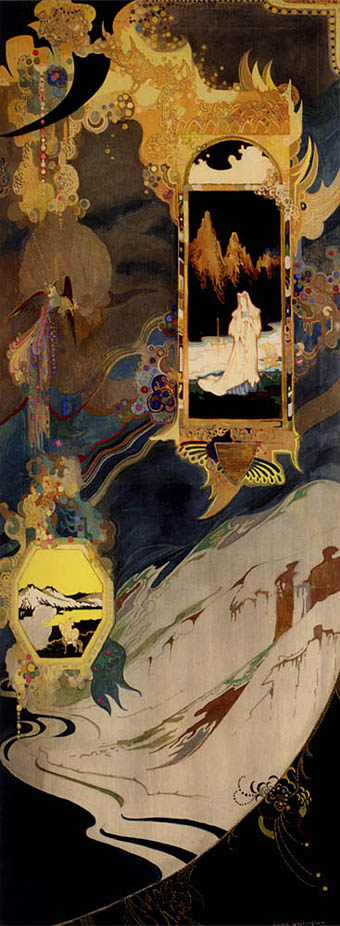Baptism of Dylan, Son of the Wave from The Cauldron of Anwn (c. 1902).
About the artist:
George Sheringham was born in London. He studied art first at the Slade School (1899–1901) before leaving for Paris, where he studied from 1904–1906. Chiefly known as a designer of stage sets and decorative artist he was also illustrator of works by Arthur Conan Doyle and Max Beerbohm. He was the author of Drawing in Pen and Pencil (1922) and Design in the Theatre (with James Laver, 1927). An invalid from 1932, he continued to paint flowers until his death.
About the work:
This striking series of paintings were commissioned by the 8th Lord Howard de Walden (Baron Seaford) to illustrate his Celtic poem, The Cauldron of Anwn. It has been suggested that they were part of a decorative sceme for de Walden and it is therefore likely that they were part of his remodelling on the interior of Seaford House in Belgravia which he undertook from 1902 onwards. The modifications at Seaford House included the panelling of the dining room and installation of an onyx staircase and frieze carved from marble imported from South America. No expense was spared and it is said that to ensure a supply of the right kind of marble, Baron Seaford bought the mine.
The series of The Cauldron of Anwyn reflects Sheringham’s interest in oriental ornamentation and also reflects modern approaches to book illustration. A close comparison can be drawn between Sheringham’s work and that of Edmund Dulac and Sheringham’s work is also suggestive of a more exotic continental approach to decoration. Sheringham had studied at the Slade School between 1899 and 1901 and in Paris between 1904 and 1906. The qualities of his work were recognised in Paris before they were in Britain and his first exhibits were at the Paris Salon. He was born and lived in London all his life and became well known as a decorative artist, applying his talents to costume and scenery design for various theatrical productions. He also illustrated many books including The Happy Hypocrite and Design in Theatre and this interest in intricate decoration was transposed into his interior design work.
• The Cauldron of Anwyn at ARC.
Elsewhere on { feuilleton }
• The illustrators archive


I am simply stunned and amazed by this painting. It’s incredible!
For a possible 21st century equivalent, check out Aya Kato.
http://www.ayakato.net/
OK, there really can be no equivalent, but there are wonderful similarities…
Yes, this was a stray find, I’d not come across his work before. The rest in the series are at the link above and worth a look as well.
Aya Kato’s work is marvellous as well–it’s been bookmarked! There is a similarity in that Aubrey Beardsley’s style was derived from Japanese prints and it was his radical refashioning of the look of Victorian art which opened the door for later artists such as Sheringham. It fascinates me seeing Japanese artists of today take back these influences by working their own variations on Victorian and Edwardian illustrators.
Beautiful. The use of such an oriental-influenced painting is rather strange to illustrate a Celtic poem, but why not…
I find the top (in particular top left) a little reminiscent of Klimt work.
“It fascinates me seeing Japanese artists of today take back these influences by working their own variations on Victorian and Edwardian illustrators.”
Precisely!!
Yes, very Klimst-esque. One of the ways that Decadent artists absorbed Modernist trends (without turning Cubist) was to flatten things out but stay decorative. Klimt is the prime example of that.
My gratitude for mentioning Kato, whom I had never heard of before. I am not sure if he sits upon the pedestal where I place Harry Clarke, but there are definite similarities of style and theme, with the illustrations of traditional folk tales and Poe’s ‘Mysteries and Imagination’ and all.
Just ravishing!
Reminds me a bit of Kay Nielsen..